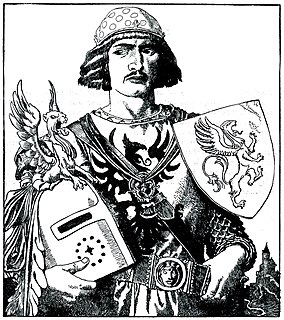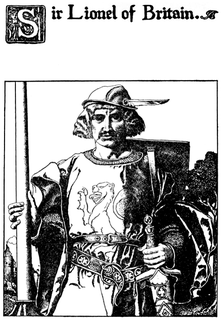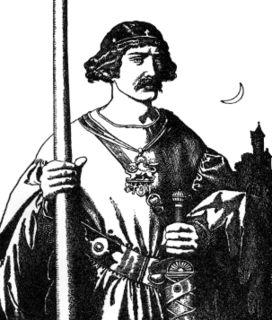Related Research Articles

Gawain, also known as Gawaine or Gauwaine, among other forms and spellings, is a character in Arthurian legend, in which he is King Arthur's nephew and a Knight of the Round Table. The prototype of Gawain is mentioned under the name Gwalchmei in the earliest Welsh sources. He has subsequently appeared in many Arthurian stories in Welsh, Latin, French, English, Scottish, Dutch, German, Spanish, and Italian, notably as the protagonist of the famous Middle English story Sir Gawain and the Green Knight. Other tales featuring Gawain as the central character include De Ortu Waluuanii, Diu Crône, The Awntyrs off Arthure, Ywain and Gawain, Golagros and Gawane, L'âtre périlleux, La Vengeance Raguidel, Le Chevalier à l'épée, The Greene Knight, and The Weddynge of Syr Gawen and Dame Ragnell.

The Green Knight is a character from the 14th-century Arthurian poem Sir Gawain and the Green Knight and the related medieval work The Greene Knight. His true name is revealed to be Bertilak de Hautdesert in Sir Gawain, while The Greene Knight names him "Bredbeddle". The Green Knight later features as one of Arthur's greatest champions in the fragmentary ballad "King Arthur and King Cornwall", again with the name "Bredbeddle". In Sir Gawain and the Green Knight, Bertilak is transformed into the Green Knight by Morgan le Fay, a traditional adversary of King Arthur, in order to test his court. In The Greene Knight he is transformed by a different woman for the same purpose. In both stories he sends his wife to seduce Gawain as a further test. "King Arthur and King Cornwall" portrays him as an exorcist and one of the most powerful knights of Arthur's court.

Sir Lionel is the younger son of King Bors of Gaunnes and Evaine and brother of Bors the Younger in Arthurian legend since the Lancelot-Grail cycle. He is a double cousin of Lancelot and cousin of Lancelot's younger half-brother Hector de Maris. He later became the subject of one of the famous Child Ballads (#18).
Sir Aldingar is Child ballad 59. Francis James Child collected three variants, two fragmentary, in The English and Scottish Popular Ballads. All three recount the tale where a rebuffed Sir Aldingar slanders his mistress, Queen Eleanor, and a miraculous champion saves her.

Sir Ywain, also known as Yvain, Owain, Uwain(e), Ewaine, Iwain, Iwein, Ivain, Ivan, etc., is a Knight of the Round Table in Arthurian legend, wherein he is often the son of King Urien of Gorre and the sorceress Morgan le Fay. The historical Owain mab Urien, on whom the literary character is based, was the king of Rheged in Great Britain during the late 6th century.

The loathly lady, is a tale type commonly used in medieval literature, most famously in Geoffrey Chaucer's The Wife of Bath's Tale. The motif is that of a woman who appears unattractive but undergoes a transformation upon being approached by a man in spite of her unattractiveness, becoming extremely desirable. It is then revealed that her ugliness was the result of a curse which was broken by the hero's action.
"The Laily Worm and the Machrel of the Sea" is Child ballad number 36.
"Kemp Owyne" is Child Ballad number 34.

"Hind Horn" is a traditional English and Scottish folk ballad.
"The Boy and the Mantle" is Child ballad number 29, an Arthurian story.
"Gil Brenton" is Child ballad 5, Roud 22, existing in several variants.
"The Knight and the Shepherd’s Daughter" is an English ballad, collected by Francis James Child as Child Ballad 110 and listed as number 67 in the Roud Folk Song Index.
"King Henry" is Child ballad 32, Roud 3967.
Sir Cawline is Child ballad 61. A fragmentary form exists in The Percy Folio.

The Wedding of Sir Gawain and Dame Ragnelle is a 15th-century English poem, one of several versions of the "loathly lady" story popular during the Middle Ages. An earlier version of the story appears as "The Wyfe of Bayths Tale" in Geoffrey Chaucer's The Canterbury Tales, and the later ballad "The Marriage of Sir Gawain" is essentially a retelling, though its relationship to the medieval poem is uncertain. The author's name is not known, but similarities to Le Morte d'Arthur have led to the suggestion that the poem may have been written by Sir Thomas Malory.
The Daughter Of King Under-Waves is a Scottish fairy tale collected by John Francis Campbell in Popular Tales of the West Highlands. He listed as his source Roderick MacLean, a tailor of Ken Tangval, Barra, who reported hearing it from old men in South Uist, including Angus Macintyre, Bornish, who was about eighty. The text was written by H. MacLean, 1860.
"King Arthur and King Cornwall" is an English ballad surviving in fragmentary form in the 17th-century Percy Folio manuscript. An Arthurian story, it was collected by Francis James Child as Child Ballad 30. Unlike other Child Ballads, but like the Arthurian "The Boy and the Mantle" and "The Marriage of Sir Gawain", it is not a folk ballad but a professional minstrel's song. It is notable for containing the Green Knight, a character known from the medieval poems The Greene Knight and the more famous Sir Gawain and the Green Knight; he appears as "Bredbeddle", the character's name in The Greene Knight.
The Awntyrs off Arthure at the Terne Wathelyne is an Arthurian romance of 702 lines written in Middle English alliterative verse. Despite its title, it centres on the deeds of Sir Gawain. The poem, thought to have been composed in Cumberland in the late 14th or early 15th century, survives in four different manuscripts from widely separated areas of England.
Sir Gawain and the Carle of Carlisle is a Middle English tail-rhyme romance of 660 lines, composed in about 1400. A similar story is told in a 17th-century minstrel piece found in the Percy Folio and known as The Carle of Carlisle. These are two of a number of early English poems that feature the Arthurian hero Sir Gawain, the nephew of King Arthur, in his English role as a knight of the Round Table renowned for his valour and, particularly, for his courtesy.
The Avowing of Arthur, or in full The Avowing of King Arthur, Sir Gawain, Sir Kay, and Baldwin of Britain, is an anonymous Middle English romance in 16-line tail-rhyme stanzas telling of the adventures of its four heroes in and around Carlisle and Inglewood Forest. The poem was probably composed towards the end of the 14th century or the beginning of the 15th century by a poet in the north of England. It exhibits many similarities of form and plot with Sir Gawain and the Green Knight and other romances of the Middle English Gawain cycle. Though formerly dismissed as an ill-organized collection of unconnected episodes, it has more recently been called a "complex and thought-provoking romance" with an effective diptych structure, which displays a wide knowledge of Arthurian and other tales and gives a fresh turn to them.
References
- Hahn, Thomas (2000). The Marriage of Sir Gawain. In Sir Gawain: Eleven Romances and Tales, pp. 359–371. Western Michigan University Medieval Institute Publications. ISBN 1-879288-59-1.